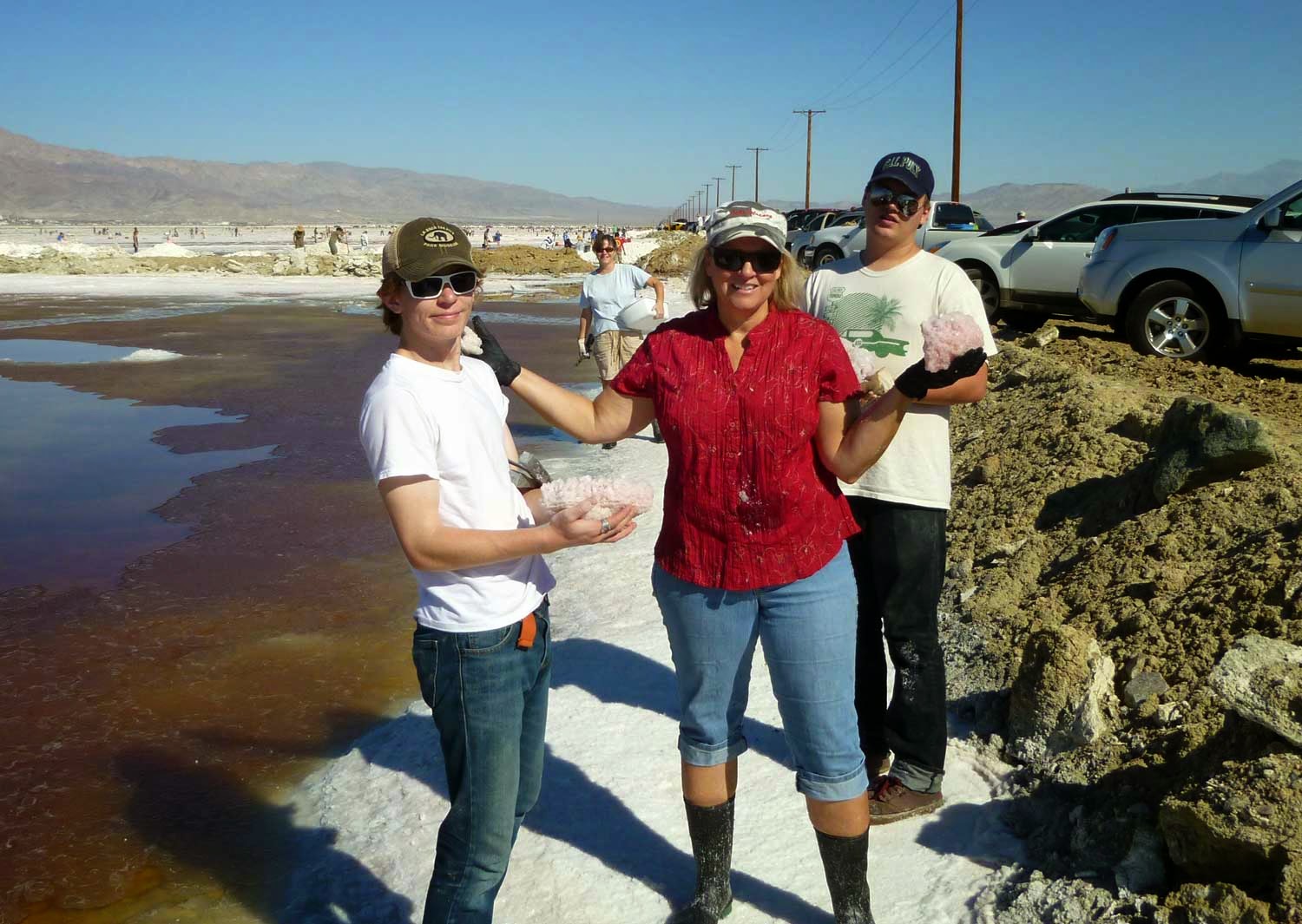The annual open weekend at Trona, California, hosted by the Searles Lake Gem & Mineral Society (http://www1.iwvisp.com/tronagemclub/GEM-O-RAMA.htm) and Searles Valley Mineral Company (SVMC, http://www.svminerals.com/default.aspx) was a fun family outing that I would encourage anyone with an interest in geology and mineralogy to attend. Directions and descriptions of the various activities are well-documented on the Society’s website, so I won’t go into great detail here, other than to relate some of the experiences that might be helpful.
Camping
I can’t comment on local hotels because we brought an RV (travel trailer) and parked at the Valley Wells Recreation Area for two nights. I filled the water tank on the RV before leaving home; this turned out to be a good thing. While water is available, it’s located at the corner of the restroom building where many of the tent campers were set up. It would have been awkward to pull into their campsites after dark to fill up the tank. We also rented a fireplace, well worth the $5 per night. I think I saw firewood available at one of the local gas stations, but we brought our own firewood, which made for a couple of very pleasant evenings.
There is plenty of level space for tents and RVs. Campers with pets stay in a separate area outside the fenced portion of the property (Thank you!). Be aware of some minimal glass and metal debris, along with sticker bushes. (Everything that grows in the desert is trying to kill you, get used to it.) For the most part, this is a clean, quiet, nice place to camp. Restrooms are available. If you leave a tent or canopy up during the day, make sure it’s wind-proofed and staked down, or it may get damaged or blown away.
The Mud Trip
The SVMC brings out several truckloads of mud from below the surface of the lake bed, dumps it on the ground and several hundred rockhounds wallow in it, finding many colossally large crystals of hanksite, halite and borax. Hanksite (http://en.wikipedia.org/wiki/Hanksite) is closely related to halite (salt), except that it also includes K, sulfate, carbonate, and forms hexagonal crystals. White borax crystals 1-2 inches long are found interspersed with 3-4 inch hanksite or halite.
As beginners, we wanted to save everything, of course. A few tips that we could have used ahead of time: I’m not sure I’d bother with the pieces of carpet. A good pair of knee-high rubber boots is worth the effort. One long shovel seemed plenty for the four of us, each found a small garden shovel helpful. Also, each person should bring a good, stiff-bristled brush to clean specimens in the brine trough. A pair of rubber-coated gloves from your local hardware store is a good idea, not that they’ll keep your hands dry, but they should help prevent you from getting too many cuts – very painful in the brine! Separating the “keepers” is important, otherwise you’ll end up with a garage full (like us). And emphasis on wearing clothes that you don’t want to keep.
Blow Hole
A series of charges are set below the surface, and the crystals are brought up under water pressure and dumped on the lake bed. There is a lot less mud in this location, but rubber boots are still recommended. Tools: rock hammer, small hand shovel and a small pry bar are useful. The size of the crystals is generally smaller, with specimens ranging from 1 to 5 cm. By looking closely, we found a few crystals of sulphohalite (http://www.mindat.org/min-3824.html) with its unique double-sided pyramid shape.
Halite Ponds
The trip to the halite ponds is where you’ll really want a pair of rubber boots for wading. The largest crystals grow up under the layers of salt that stick out from the edges of the pools. To free these up, you’ll need to wade in to avoid putting weight on the fragile surface. A small pry bar of 18-24 inches would be helpful, too. There you will find masses of intergrown hopper-shaped (http://en.wikipedia.org/wiki/Hopper_crystal) halite crystals up to 3 cm across, infused with the red algae making them a beautiful pink color.
Cleaning and Preserving
For the hanksite specimens collected from the mud, wash and remove the major covering, but it’s important not to get them too clean. A fine sheen of recrystallized material will quickly develop, dulling the shiny crystal faces. It’s better to leave them somewhat covered so that they may be cleaned carefully at home, and preserved before recrystallization occurs. Purchase 2-3 gallons of brine from the store to take home with you. A few minutes to a few hours soaking in the brine will enable you to clean out the mud from each face and crevice. It’s detailed work, but worth the effort. We used wood carving tools with great success – the metal picks and blades worked well for scraping off the excess without damaging the shiny surfaces. Dry each specimen carefully when you’re done cleaning, then spray them with shellac to preserve the transparency of the crystals. Mineral oil has been recommended, but it requires recoating with time. Make sure to rinse your work area thoroughly to prevent salt damage – especially to your lawn, driveway, cars, and of course bicycles.
We had a great time and will plan on returning next year. The weather was perfect, highs about 85-90. Bring plenty of water and sunscreen.






No comments:
Post a Comment